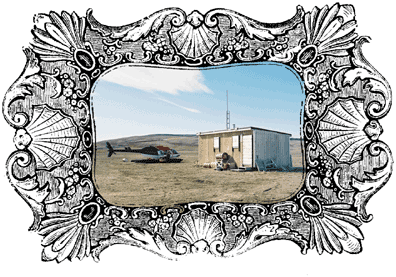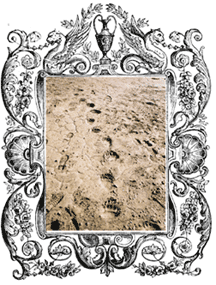GRIZZLY BEARS TAKE NORTHERN VACATION
(photographs by Mark Furze)

A paw print, a hair, and a photograph are all clues that Canada’s grizzly bears are on the move.
Recently, Canadian scientists genetically confirmed the sighting of a grizzly bear more than 1000 kilometers north of the species’ known range, proving that Canadians still have a lot to learn about our northern-most animals.
Grizzlies seem to be encroaching on the territory of polar bears, a species already threatened by global warming. The two species previously met only on the sea ice near mainland Canada, where they both hunt seals. Though polar bears are generally larger, grizzlies have been spotted preying on polar bear cubs.
In July of 2003, University of Alberta geologist John England flew to Melville Island, shared by Nunavut and the Northwest Territories and more than 1000 kilometers north of mainland Canada, to begin his field season. His helicopter dropped off a group of biologists to collect mosses at the southern end of the island, and started heading north.
“We took off and had gone about a kilometer away in the main valley leading to the coast, and we saw a bear,” said England. “We assumed it was a polar bear, but we wanted to make sure with the helicopter that it was going down the valley towards the sea and not up-valley, to where the people were collecting.”
The helicopter’s pilot brought the craft closer to the animal, which looked too dark to be a polar bear, England said. “We swung around and went over the bear a couple of times and took some photographs, and it was very apparent that this was not a polar bear, it was definitely a grizzly bear—it had a really distinctive hump on its back, a shorter snout, wider face, and very strong colouration.”

Traditionally, grizzly bears were only thought to live as far north as the edge of mainland Canada, but Inuit hunters have spotted them on Banks and Victoria Islands in recent years.
“If you were to look at a map of mainland Canada and the Arctic Islands, Victoria Island is not a long distance from the mainland,” said England. “But when you get to the north end of Victoria Island, you’ve got about 80 to 100 kilometers of ocean or sea ice before you can get to Melville Island. It’s not like you can look from Victoria Island and see Melville Island. This bear had to cross over the sea ice, which is a very great distance.”
It was a shock to think a grizzly would wander so far. Surely it wouldn’t stay.
The following summer a post-doctoral fellow in England’s research group, Jonathon Doupe, returned to Melville Island. Doupe and the pilot of his helicopter stopped at a cabin meant to protect travelers from the high numbers of polar bears in the region. Near the cabin, the pair spotted bear tracks. Doupe assumed that they belonged to one of the many polar bears nearby.
But the pilot was adamant that they couldn’t belong to a polar bear because of the long claw marks in front of the toes—only grizzlies have long claws, used for ripping open logs to search for grubs.
The side of the cabin was scratched, and several brown hairs were stuck in the wood. “Bears will go up to a cabin and start rubbing themselves or scratching themselves on it,” said Doupe. “It looked like this bear had done that, gone right up to the cabin.”
Doupe collected the hairs and delivered them to a wildlife forensics expert in Edmonton, who noticed the hairs were brown with white tips, a characteristic of grizzly bears.
A geneticist was able to extract DNA from some dried skin left clinging to one of the hairs. He used a well-developed set of microsatellite DNA markers to conclusively identify the hairs as grizzly bear. In fact, Doupe said, “they were ten million times more likely to be grizzly bear than polar bear.”
The Melville Island sightings are the farthest north that grizzly bears have been spotted. In 1991, one was spotted on the sea ice south of Melville Island near several seal pup carcasses. The bear was tranquilized and tattooed before it was released.
Melville Island was surveyed extensively during oil and gas explorations in the 1970s, and no grizzly bears were reported. England and Doupe suggest that the bears they’ve seen are the first in the area, although they can’t be sure if global warming, human development in grizzly habitats or the pluckiness of a single bear is responsible for the move north.
More research is necessary to determine how many grizzlies live on Melville Island, and how they will interact with resident polar bears. England believes that there is a reliable source of food for grizzlies on the island. “This bear was quite healthy from all appearances—it was big, it was very heavy set, and certainly didn’t appear to be out of its element at all.”
England says that his group’s discovery shows how little we know about the North. “The arctic islands have their own surprises, and they’re undergoing their own changes, and it’s always exciting to come across something that’s unexpected. It just reminds you that you shouldn’t assume that things are fixed.”